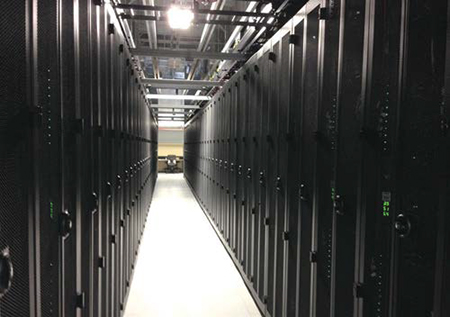Anyone who attended (or read about) this year’s NAB Show was unable to escape what was probably the biggest trend in our industry: the transition to IP and the increasing acceptance of the concept of “cloud” storage and computing for media operations. While there is still some skepticism about its role in our industry, there is also an increasing acknowledgement that we’re heading towards a cloud-based ecosystem.
Whether it’s wired or wireless, IP or traditional broadcast, the concept of handling the various elements of the media production workflow—from ingest to playout— within the cloud will be required if our industry wants to fulfill today’s mandate of delivering media anytime to any device. Whether you have a smart device or just a simple PC, you’re already using and taking advantage of the flexibility and robustness of cloud computing in both your personal and professional daily life.

Data servers at NetApp’s data center in Morrisville, N.C. The ATSC realizes the importance of the cloud for the future of broadcasting. “The ATSC 3.0 transport layer is based on using IP encapsulation for streaming and file delivery, rather than the MPEG-2 Transport Stream encapsulation as is currently used,” said ATSC President Mark Richer. “Besides similarities to the Internet, the use of IP transport enables incorporation of hybrid services, where components of services can be delivered by broadcast and broadband in a way that they can be synchronized. Woven throughout the structure of ATSC 3.0 is the basic notion that components of services can be delivered by different mechanisms (broadcast, broadband, or even pre-delivered by push in advance) and combined as needed to create services. This gives the broadcaster a large degree of flexibility and control over the services they offer.”
As our industry has progressed and the use of the cloud for the delivery of virtualized storage-on-demand has become more commonplace, vendors have added services and capabilities that take advantage of the increasing availability of IP-based delivery and high-speed connections. I had a chance to discuss these trends with a number of industry colleagues at this month’s NewBay Media “Cloud Tech Summit” in Raleigh, N.C. Although the conference was off-the-record, I can say that there was a general consensus that cloud computing has advanced enough to make the technology—whether it’s public, private or “hybrid” (a combination of both cloud and on-premise storage that has become a more popular option in our industry)— easier and more reliable to use. Improving workflows and the ability to deploy new channels and services on the fly—with little to no additional hardware or manpower needed—are among the most attractive features of cloud computing for our industry.
Nevertheless, there is still understandable skepticism about reliability, cost and security. In an industry whose livelihood depends on high-value content, there is still a reluctance to hand over certain parts of the workflow chain to third parties. And what happens when the Internet goes down? Industry players such as Amazon’s AWS, Microsoft Azure and others have taken steps to alleviate such concerns but it will take time before more broadcasters get onboard. While it may be inevitable, many of us are still weighing the risks such a universal transition will entail.
In our “Moving to IP” special report in this issue, we look at some of these trends, including the use of software-defined networking and software-as-a-service (SaaS) that are making the use of cloud technologies more relevant for our industry.
The cloud is an essential, critical part of our future.
The professional video industry's #1 source for news, trends and product and tech information. Sign up below.
Tom has covered the broadcast technology market for the past 25 years, including three years handling member communications for the National Association of Broadcasters followed by a year as editor of Video Technology News and DTV Business executive newsletters for Phillips Publishing. In 1999 he launched digitalbroadcasting.com for internet B2B portal Verticalnet. He is also a charter member of the CTA's Academy of Digital TV Pioneers. Since 2001, he has been editor-in-chief of TV Tech (www.tvtech.com), the leading source of news and information on broadcast and related media technology and is a frequent contributor and moderator to the brand’s Tech Leadership events.

